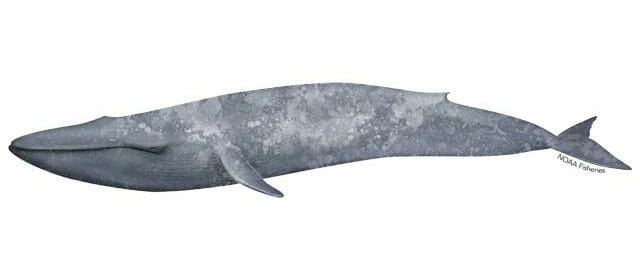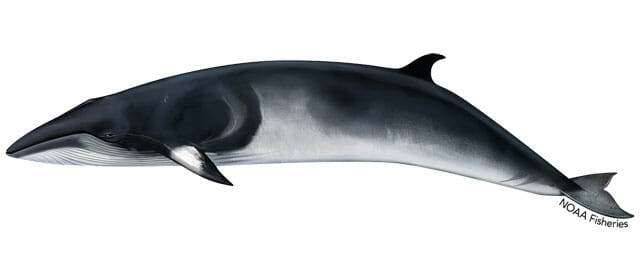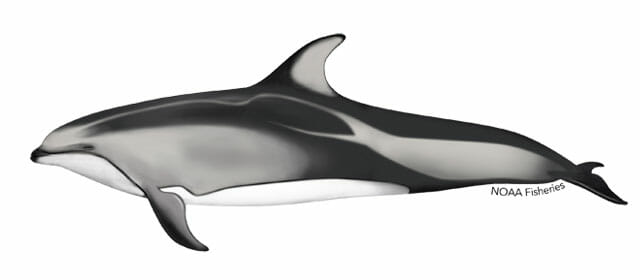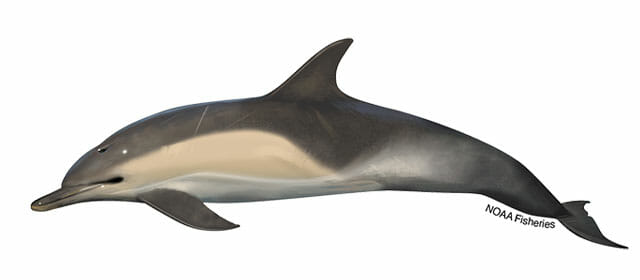Meet Our Cetaceans
Santa Barbara Channel is Home to an Amazing Amount of Marine Life
The Santa Barbara Channel is home to an incredibly diverse collection of cetaceans, including blue whales, gray whales, humpbacks, dolphins, and beyond. Keep reading to learn more about the various species located in the Santa Barbara Channel. To learn even more about cetaceans, fish, sharks, corals, and other amazing marine life, visit the NOAA Fisheries Site at https://www.fisheries.noaa.gov/find-species

Blue Whales
Blue whales are the largest animals ever to live on our planet. They feed almost exclusively on krill, straining huge volumes of ocean water through their baleen plates (which hang from the roof of the mouth and work like a sieve). Some of the biggest individuals may eat up to 6 tons of krill a day. Learn More About Blue Whales

Bryde's Whales
Bryde's (pronounced "broodus") whales are members of the baleen whale family. They are considered one of the "great whales," or rorquals, which is a group that also includes blue whales and humpback whales. Bryde’s whales are named for Johan Bryde, a Norwegian who built the first whaling stations in South Africa in the early 20th century. Learn More

Fin Whales
The fin whale is the second-largest whale species on earth, second only to the blue whale. It is found throughout the world’s oceans. It gets its name from an easy-to-spot fin on its back, near its tail. Read More

Gray Whales
Once common throughout the Northern Hemisphere, gray whales are now only regularly found in the North Pacific Ocean where there are two extant populations, one in the eastern and one in the western North Pacific. Learn More About Gray Whales

Humpback Whales
Before a final moratorium on commercial whaling in 1985, all populations of humpback whales were greatly reduced, most by more than 95 percent. The species is increasing in abundance throughout much of its range but faces threats from entanglement in fishing gear, vessel strikes, vessel-based harassment, and underwater noise. More About Humpback Whales

Minke Whales
Minke whales are members of the baleen or “great” whale family and are the smallest of the rorquals. They are one of the most abundant rorqual in the world, and their population status is considered stable throughout almost their entire range (especially when compared to other species of large whales). Learn more About Minke Whales.

Sperm Whales
Sperm whales are the largest of the toothed whales and have one of the widest global distributions of any marine mammal species. They are found in all deep oceans, from the equator to the edge of the pack ice in the Arctic and Antarctic. They are named after the waxy substance—spermaceti—found in their heads. Learn More About Sperm Whales

Common Bottlenose Dolphin
Common bottlenose dolphins (referred to hereafter simply as bottlenose dolphins) are found throughout the world in both offshore and coastal waters, including harbors, bays, gulfs, and estuaries of temperate and tropical waters. They are one of the most well-studied marine mammals in the wild. In addition, they are easy to view in the wild because they live close to shore and are distributed throughout coastal and estuarine waters. Read More

Dall's Porpoise
Dall's porpoises are common in the North Pacific Ocean and can be found off the U.S. West Coast from California to the Bering Sea in Alaska. These porpoises are considered the fastest swimmers among small cetaceans, reaching speeds of 34 miles per hour over short distances. They are named for W.H. Dall, an American naturalist who collected the first specimen of this species. Learn More

False Killer Whale
False killer whales are social animals found globally in all tropical and subtropical oceans and generally in deep offshore waters. The false killer whale’s entire body is black or dark gray, although lighter areas may occur ventrally (on its underside) between the flippers or on the sides of the head. Keep Reading

Harbor Porpoise
The harbor porpoise is a shy animal, most often seen in groups of two or three. They prefer coastal areas and are most commonly found in bays, estuaries, harbors, and fjords. Because they prefer coastal habitats, harbor porpoises are particularly vulnerable to gillnets and fishing traps, pollution, and other types of human disturbance, such as underwater noise. Read More

Killer Whale
The killer whale, also known as orca, is the ocean’s top predator. It is the largest member of the Delphinidae family, or dolphins. Members of this family include all dolphin species, as well as other larger species, such as long-finned pilot whales and short-finned pilot whales, whose common names also contain "whale" instead of "dolphin." Read More

Long-Beaked Common Dolphin
Long-beaked common dolphins can be found in large social groups in the Atlantic, Indian, and Pacific Oceans. This highly social and energetic species prefers shallow, tropical, subtropical, and warmer temperate waters closer to the coast and on the continental shelf. Read More

Pacific White-Sided Dolphin
Pacific white-sided dolphins, known for the distinct coloring that give them their name, are a playful and highly social marine mammal. They are also sometimes known as the “hookfin porpoise” because of their large, curved dorsal fin, though they are not technically porpoises. Keep Reading at NOAA.

Risso's Dolphin
Risso's dolphins, sometimes called gray dolphins, are found in the temperate and tropical zones of all the world’s oceans. These cetaceans generally prefer deeper offshore waters, especially near the continental shelf edge and slope, where they can dive to at least 1,000 feet and hold their breath for 30 minutes. They are also very active on the ocean surface. Learn More

Short-Beaked Common Dolphin
hort-beaked common dolphins are one of the most abundant and familiar dolphins in the world. This highly social and energetic species is widely distributed, preferring warm tropical to cool temperate waters that are primarily offshore. Short-beaked common dolphins are often found in association with underwater ridges, seamounts, and continental shelves where upwelling (a process in which deep, cold, nutrient-rich water rises toward the surface) occurs and prey is abundant. Learn More at NOAA

Short-Finned Pilot Whale
Short-finned pilot whales are found globally in tropical and temperate oceans. They are one of two species of pilot whale, along with the long-finned pilot whale. The two species differ slightly in size, features, coloration, and pattern. In the field and at sea, it is very difficult to tell the difference between the two species. Keep Reading to Learn More
A HUGE thank you to NOAA Fisheries for access to these amazing illustrations and information. Learn more at https://www.fisheries.noaa.gov.

